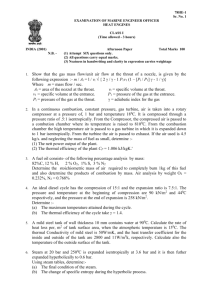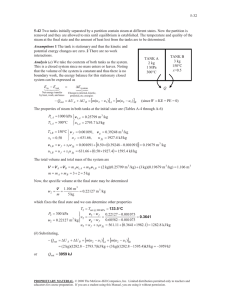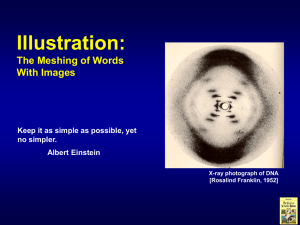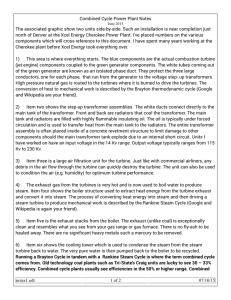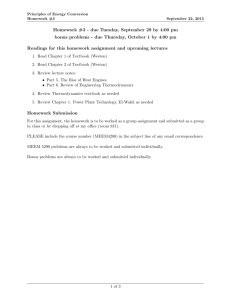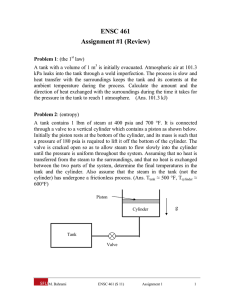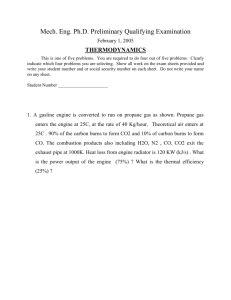Example Problem Set
advertisement
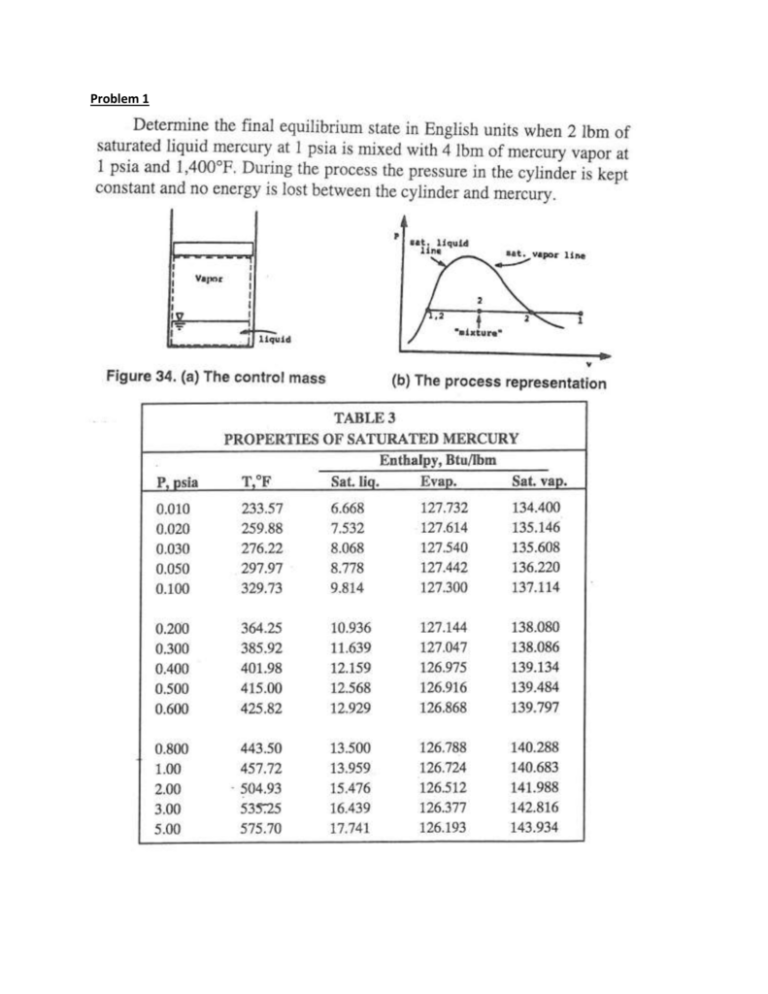
Problem 1 Answer: h2 = 114 Btu/lbm; x2 = 0.79 Problem 2 Answer: = 0.317 Problem 3 Answer: W = 91 kJ; Q = 771.1 kJ Problem 4 Answer: = 0.344; = 0.349; = 0.3595; = 0.360 Problem 5 An ideal Otto cycle has a compression ratio of 8. At the beginning of the compression process, air is at 100 kPa and 17 °C, and 800 kJ/kg of heat is transferred to air during the constant-volume heat-addition process. Assume cP = 7/2 R. Determine (a) the maximum temperature and pressure that occur during the cycle, (b) the net work output, and (c) the thermal efficiency. Answer: W = 481.8 kJ/kg; = 0.565 Problem 6 A gas is confined in a cylinder by a piston. It is taken from state A to state B along the path ACB as shown on the PV diagram below. The process from A to C is constant pressure, and the system receives 50 J of work and gives up 25 J of heat to the surroundings. The process from C to B is constant volume and the system receives 75 J of heat. The return path from B to A is adiabatic. How much work is exchanged with the surroundings for the adiabatic path? Assume all processes are frictionless. B P C A V Answer: W = 100 J/kg Problem 7 Water at 200 ºF is pumped from a storage tank at the rate of 50 gal min-1. The motor for the pump supplies work at the rate of 2 hp. The water goes through a heat exchanger, giving up heat at the rate of 40 000 Btu min-1, and is delivered to a second storage tank at an elevation 50 ft above the first tank. What is the temperature of the water delivered to the second tank? The density of water at 200 ºF is 60.1 lbm ft-3. Answer: T2 = 100.74 °C Problem 8 Air at 1 bar and 298.15 K is compressed to 5 bar and 298.15 K by two different frictionless (reversible) processes: (a) Cooling at constant pressure followed by heating at constant volume (b) Heating at constant volume followed by cooling at constant pressure Calculate the heat and work requirements and the change in internal energy and enthalpy of the air for each path. Assume that air is an ideal gas, regardless of the changes it undergoes and that Cp = Cv + R. At 298.15 K and 1 bar the molar volume of air is 0.02479 m3 mol-1. Answer: (a) W = -1983 J; Q = -1983 J (b) W = -9915 J; Q = -9915 J Problem 9 A well-insulated storage tank with a diameter of 10 m and a volume of 60 m3 contains 200 L of saturated liquid water at 75 ºC. The rest of the tank contains steam in equilibrium with the water. Spent process steam enters the storage tank through a 0.25 m pipe at 2 bar and 90% quality until the pressure in the tank reaches 2 bar. Assuming that the heat losses from the system to the tank and the environment are negligible, calculate the total amount of steam that enters the tank during the filling process and the fraction of liquid water present at the end of the process. Answer: m = 73.48 kg; xL= 0.761; Problem 10 A central power plant, rated at 800,000 kW, generates steam at 585 K and discards heat to a river at 295 K. If the thermal efficiency of the plant is 70% of the maximum possible value, how much heat is discarded to the river at rated power? Answer: Qc = -1.505×106 kW Problem 11 The following heat engines produce power of 95,000 kW. Determine in each case the rates at which heat is absorbed from the hot reservoir and discarded to the cold reservoir. 1. A Carnot engine operates between heat reservoirs at 750 K and 300 K. 2. A practical engine operates between the same heat reservoirs but with a thermal efficiency = 0.35. Answer: (1) Qc = -6.33×104 kW; QH = 1.583×105 kW; (2) Qc = 2.71×105 kW; QH = -1.76×105 kW Problem 12 Steam generated in a power plant at a pressure of 8000 kPa and a temperature of 500 ºC is fed to a turbine. Exhaust from the turbine enters a condenser at 10 kPa, where it is condensed to saturated liquid, which is then pumped to the boiler. a) What is the thermal efficiency of a Rankine cycle operating at these conditions? b) What is the thermal efficiency of a practical cycle operating at these conditions if the turbine efficiency and pump efficiency are both 0.75? c) If the rating of the power cycle of part (b) is 80,000 kW, what is the steam rate and what are the heat-transfer rates in the boiler and condenser? Answer: (a) = 0.394; (b) = 0.294; (c) m = 85.1 kg/s, Qh = 2.7 × 105 kJ/s, Qc = 1.9 × 105 kJ/s
